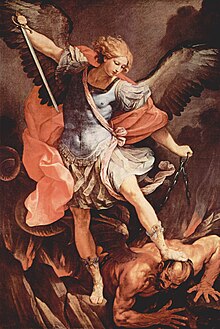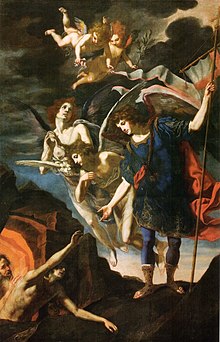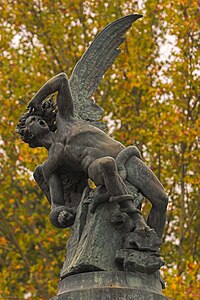
Angels are usually viewed as messengers of a supreme divine being, sent to do the tasks of that being. Traditions vary as to whether angels have free will. While the appearance of angels also varies, many views of angels give them a human shape. Despite a common popular belief— or at least metaphor— that angels are former human beings, most major religious groups deny such a view, and this position is held only by Latter Day Saints and the Bahá'í Faith.
Latter Day Saint beliefs

The Latter Day Saint movement (generally called "Mormons") view angels as the messengers of God. They are sent to mankind to deliver messages, minister to humanity, teach doctrines of salvation, call mankind to repentance, give priesthood keys, save individuals in perilous times, and guide humankind.[12]
Latter Day Saints believe that angels are former human beings or the spirits of human beings yet to be born,[13] and accordingly Joseph Smith taught that "there are no angels who minister to this earth but those that do belong or have belonged to it."[14] As such, Latter Day Saints also believe that Adam (the first man) is now the archangel Michael,[15][16] and that Gabriel lived on the earth as Noah.[13] Likewise the famous Angel Moroni first lived in a pre-Columbian American civilization as the 5th-century prophet-warrior named Moroni.
Joseph Smith, Jr. described his first angelic encounter thus:[17]
While I was thus in the act of calling upon God, I discovered a light appearing in my room, which continued to increase until the room was lighter than at noonday, when immediately a personage appeared at my bedside, standing in the air, for his feet did not touch the floor.
He had on a loose robe of most exquisite whiteness. It was a whiteness beyond anything earthly I had ever seen; nor do I believe that any earthly thing could be made to appear so exceedingly white and brilliant....
Not only was his robe exceedingly white, but his whole person was glorious beyond description, and his countenance truly like lightning. The room was exceedingly light, but not so very bright as immediately around his person. When I first looked upon him, I was afraid; but the fear soon left me.
Most angelic visitations in the early Latter Day Saint movement were witnessed by Joseph Smith and Oliver Cowdery, who both claimed (prior to the establishment of the Church[when?]) to have been visitated by the prophet Moroni, the Book of Mormon prophet Nephi, John the Baptist, and the Apostles Peter, James, and John. Later, at the dedication of the Kirtland Temple, Smith and Cowdery claimed to have been visited by Jesus, and subsequently by Moses, Elias, and Elijah.[18]
People who claimed to have received a visit by an angel include the other two of the three witnesses: David Whitmer and Martin Harris. Many other Latter Day Saints, both in the early and modern church, have claimed to have seen angels, though Smith posited that, except in extenuating circumstances such as the restoration, mortals teach mortals, spirits teach spirits and resurrected beings teach other resurrected beings. [19]
I died as inanimate matter and arose a plant,
I died as a plant and rose again an animal.
I died as an animal and arose a man.
Why then should I fear to become less by dying?
I shall die once again as a man
To rise an angel perfect from head to foot!
Again when I suffer dissolution as an angel,
I shall become what passes the conception of man!
Let me then become non-existent, for non-existence
Sings to me in organ tones, 'To him shall we return.
Archangel Michael: Roman Catholic traditions and views
From Wikipedia, the free encyclopedia

Archangel Michael is referred to in the Old Testament and has been part of Christian teachings since the earliest times.[1] However, throughout the centuries specific Roman Catholic traditions and views on Archangel Michael (also called Saint Michael by Catholics) have taken shape, as recently as the 19th and 20th centuries. For instance, a specific Prayer to Saint Michael was promoted by Pope Leo XIII in 1888 and as recently as 1994 was reinforced by Pope John Paul II who encouraged the Catholic faithful to continue to pray it, saying: "I ask everyone not to forget it and to recite it to obtain help in the battle against forces of darkness.”[2][3][4]
Archangel Michael has specific roles within Roman Catholic teachings that range from acting as the chief opponent of Satan to the saving of souls at the hour of death. Roman Catholic literature and traditions continue to point to Saint Michael in contexts as varied as the protection of the Catholic Church to the Consecration of Russia by popes Pius XII and John Paul II regarding the messages reported at Our Lady of Fatima. This article reviews these Roman Catholic teachings and traditions.
The Archangels

Angels in general, and archangels in particular, have specific roles within Roman Catholic teachings. The Catechism of the Catholic Church (334-335) states that:[5]
"The whole life of the church benefits from the mysterious and powerful help of the angels.... From its beginning until death, human life is surrounded by their watchful care and intercession."
The three angels named in the Bible are Michael, Gabriel and Raphael. Michael means "Who is like God", Gabriel means "Power of God" and Raphael means "God heals".[6] The feast of these three archangels is celebrated on September 29. Within the hierarchy of the angels, at the highest level, St. Michael is a princely Seraph.[7] The word archangel comes from the Greek words arche (prince) and angelos (messenger). The prophet Daniel (12: 1) called him "Michael the great prince who shall rise at the time of the end."[8]
Christian art often portrays archangels together. For instance Archangels Michael and Gabriel are jointly depicted on Our Lady of Perpetual Help, a Byzantine icon of the Blessed Virgin Mary that is has been the subject of widespread Catholic devotions for centuries.
Defeat of the Adversary and the Fallen angels

In Catholic teachings, Saint Michael is viewed as the leader of the army of God. From the time of the apostles, he has been invoked and honored as the protector of the Church. Scripture describes him as "one of the chief princes" and the leader of Heaven's forces in their triumph over the powers of hell.[11]
Saint Michael defeats Satan twice, first when he ejects Satan from Paradise, and then in the final battle of the end times. In his classic book Lives of the Saints, priest and hagiographer Alban Butler, defined the role of Saint Michael as follows:[12]
"Who is like God?" was the cry of Archangel Michael when he smote the rebel Lucifer in the conflict of the heavenly hosts. And when Antichrist shall have set up his kingdom on earth, it is St Michael who will unfurl once more the standard of the cross, sound the last trumpet, bind together the false prophet and the beast and hurl them for all eternity into the burning pool.
It was Saint Michael who vanquished Satan and drove him out of Heaven. In the Book of Revelation (Rev 12, 7-9) Saint John wrote of Archangel Michael's role in the War in Heaven where he hurls Satan and the Fallen angels out of heaven to earth:[13]
"And there was war in heaven. Michael and his angels fought against the dragon, and the dragon and his angels fought back. But he was not strong enough, and they lost their place in heaven. The great dragon was hurled down — that ancient serpent called the devil, or Satan, who leads the whole world astray. He was hurled to the earth, and his angels with him."
Depictions of Saint Michael often portray the scene where Satan, or the fallen angels, are helplessly below the sword or spear of a triumphant Saint Michael whose face often displays intense concentration.[14] In some depictions, the Latin phrase Quis ut Deus? can be seen on the shield of Saint Michael. The phrase means "Who is like God?" and Saint Michael asks it scornfully as he slays Satan, represented as a dragon, or a man-like figure, at times with wings.[15][16]
In Catholic teachings, Saint Michael will also triumph at the end times when Antichrist will be defeated by him.[17] In the Bible, The Book of Daniel states:[18]
"At that time Michael, the great prince who protects your people, will arise. There will be a time of distress such as has not happened from the beginning of nations until then. But at that time your people - everyone whose name is found written in the book - will be delivered.
In the Roman Catholic tradition, Saint Michael is the angelic model for the virtues of the spiritual warrior, a paradigm extended to other warrior saints. The conflict against evil may at times be viewed as the battle within. It requires great courage and forebearance to step onto the inner battlefield and strike down whatever internal demons stand on the way to sanctity. The concept of the warrior saint has extended to other Catholic saints, beginning with examples such as Saint George and Saint Theodore of Amasea. [19]
[edit] Saving souls at the hour of death

In Roman Catholic teachings, Saint Michael is one of the angles who are assumed present at the hour of a person's death. In his role as the patron of holy souls, Archangel Michael reaches to souls near death and saves them, hence frusterating Satan. Traditionally, he is charged to assist the dying and accompany their souls to their private judgment, bring them to purgatory and afterward present them to God at their entrance to Heaven.
This is the reason for dedicating cemetery chapels to him, and all over Europe thousands of such chapels bear his name, and at times weekly masses are offered in his honor and in favor of the departed ones in these chapels.[20]
This role of Saint Michael as the guardian of the souls to be redeemd is also reflected in Catholic prayers to the saint, e.g.:[21]
The Holy House of God venerates you
as her guardian and protector;
to you the Lord has entrusted
the souls of the redeemed
to be led into Paradise.
[edit] Weighing soul on Judgment Day
In Catholic teachings, on Judgment Day Saint Michael weighs souls based on their deeds during their life on earth. Saint Michael is often portrayed in art with scales as he weighs souls.[22]
This aspect of Saint Michael's duties is portrayed in Roman Catholic poetry devoted to him, e.g.:[23]
"That you will gather the souls of the righteous and the wicked,
place us on your great scales and weigh our deeds.
That if we have been loving and kind, you will take the key from around
our neck and open the gates of Paradise, inviting us to live there for ever.
And that if we have been selfish and cruel, it is you who will banish us."
This role of Archangel Michael was depicted by Michaelangelo on the ceiling of the Sistine Chapel in the Vatican. In this depiction, angels hold up two books: the smaller book held by Archangel Michael records the names of the blessed, while the larger book is a list of the damned.[24]
Fallen angel
From Wikipedia, the free encyclopedia

In most Christian traditions, a fallen angel is an angel who has been exiled or banished from Heaven.
Often such banishment is a punishment for disobeying or rebelling against God. The best-known fallen angel is Lucifer. Lucifer is a name frequently given to Satan in Christian belief. This usage stems from a particular interpretation, as a reference to a fallen angel, of a passage in the Bible (Isaiah 14:3-20) that speaks of someone who is given the name of "Day Star" or "Morning Star" (in Latin, Lucifer) as fallen from heaven. The Greek etymological synonym of Lucifer, Εωσφόρος (Eosphoros, "light-bearer")[1] [2] is used of the morning star in 2 Peter 1:19 and elsewhere with no relation to Satan. But Satan is called Lucifer in many writings later than the Bible, notably in Milton's Paradise Lost (7.131-134, among others), because, according to Milton, Satan was "brighter once amidst the host/Of Angels, than that star the stars among."[3]
- Angel of God, my guardian dear
- to whom God's love commits me here.
- Ever this day/night be at my side
- to light, to guard, to rule and guide.
- Amen.




No comments:
Post a Comment